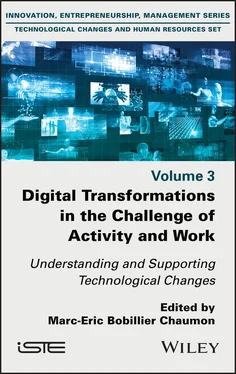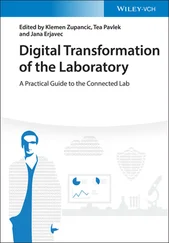Digital Transformations in the Challenge of Activity and Work
Здесь есть возможность читать онлайн «Digital Transformations in the Challenge of Activity and Work» — ознакомительный отрывок электронной книги совершенно бесплатно, а после прочтения отрывка купить полную версию. В некоторых случаях можно слушать аудио, скачать через торрент в формате fb2 и присутствует краткое содержание. Жанр: unrecognised, на английском языке. Описание произведения, (предисловие) а так же отзывы посетителей доступны на портале библиотеки ЛибКат.
- Название:Digital Transformations in the Challenge of Activity and Work
- Автор:
- Жанр:
- Год:неизвестен
- ISBN:нет данных
- Рейтинг книги:4 / 5. Голосов: 1
-
Избранное:Добавить в избранное
- Отзывы:
-
Ваша оценка:
- 80
- 1
- 2
- 3
- 4
- 5
Digital Transformations in the Challenge of Activity and Work: краткое содержание, описание и аннотация
Предлагаем к чтению аннотацию, описание, краткое содержание или предисловие (зависит от того, что написал сам автор книги «Digital Transformations in the Challenge of Activity and Work»). Если вы не нашли необходимую информацию о книге — напишите в комментариях, мы постараемся отыскать её.
Digital Transformations in the Challenge of Activity and Work — читать онлайн ознакомительный отрывок
Ниже представлен текст книги, разбитый по страницам. Система сохранения места последней прочитанной страницы, позволяет с удобством читать онлайн бесплатно книгу «Digital Transformations in the Challenge of Activity and Work», без необходимости каждый раз заново искать на чём Вы остановились. Поставьте закладку, и сможете в любой момент перейти на страницу, на которой закончили чтение.
Интервал:
Закладка:
– Virtual reality makes it possible to extract ourselves from physical reality in order to virtually change time, place and/or types of interaction. It gives a person the opportunity to engage in sensory-motor and cognitive activity in an artificial, digitally recreated world (Fuchs et al. 2006). It allows us to simulate what we would do in a normal and real situation. These devices are often used in the field of vocational training: employees find themselves in situations close to their actual working conditions, which are difficult to reproduce (Ganier et al. 2013). For example, it may be necessary to simulate the altitude to carry out a technical intervention at the top of an electrical pylon, or to carry out a difficult operation on a patient, with medical complications. Virtual reality can also be used in the medical field to treat anxiety-provoking situations (treatment of post-traumatic stress disorder (Moraes et al. 2016) or delusions of persecution (Freeman et al. 2016)).
– Augmented reality consists of adding/enriching virtual information above the real physical environment using a video headset, a computer or any other projection system (Marsot et al. 2009). There are applications for productive or maintenance tasks (such as indicating to the operator very precisely the location of rivets to be screwed on the aircraft’s cabin: the targets are then projected virtually on the surface) or when the operator wearing a headset is presented virtually with the sequences and location of the various operations to be performed to change a part on a large industrial machine (the steps and circuit to be changed appear superimposed on the engine). We therefore interact with the virtual in order to know how to act on the real thing.
– Augmented virtuality (tangible environment) consists of integrating real entities into a virtual environment; both can interact together (Fleck and Audran 2016). For example, an architect will physically manipulate models of houses in a virtually recreated living space in order to evaluate the best exposure to sun and wind and thus calculate possible energy losses. In this case, we interact with reality to act on the virtual.
The integration of these various immersive technologies (virtual reality, augmented reality, augmented virtuality) is called mixed reality (Moser et al . 2019).
All these new generations of technologies are thus intended to replace/improve all or part of human functions (physical, sensory and/or cognitive). The objective is to optimize the capacities at work (learning, understanding, decision-making, action, etc., both individual and collective) and to make work processes more efficient and effective in order to increase reactivity and profitability. According to a very deterministic approach, it also appears that the choice of such systems aims at the emergence of a working model oriented towards individual excellence, organizational agility, collective intelligence and also an efficient mutualization of the activity (between humans and machines). This would also explain the enthusiasm of companies for such systems, as Champeaux and Bret (2000, p. 45) have already mentioned, for technologies that are now more traditional: “Adopting them is no longer an opportunity, but an obligation. It is no longer a question of whether we are going to go there, but of how we are going to go there, that is, with what strategy, what investments, what objectives”.
However, while it appears that technology can affect certain dimensions of the activity, it cannot determine or shape it according to predefined and expected patterns. There is no technological determinism in the strict sense of the term. In other words, a technological innovation does not in itself impose a single type of organization or business model, but makes various forms of it possible. It is indeed the use (i.e. the conditions of use of the tool – individual, collective, organizational, etc., the project and the experiences of the user…) and not the intrinsic characteristics of the technology that will determine its effects, which can therefore be contrasted. It is these paradoxes that we will now examine in the following section.
1.3. Five paradoxes of the diffusion of technologies in/on the activity
1.3.1. Sense of loss of control over the activity vs increased control over the activity
The multiplication of digital media at work (shared digital schedules and spaces, messaging and social networks, collaborative platforms, reporting tools) is accompanied by a requirement for permanent availability and reactivity. The activity is thus increasingly determined, punctuated and emphasized by the various digital injunctions, warnings and solicitations. In the research we conducted on the impact of technology on the management profession (Bobillier Chaumon et al . 2018), we identified a category that we called “self-service or dispossessed managers”. They felt deprived of their ability to define or control their work schedule (work “imposed” by shared schedules) or simply to keep and achieve the objectives they had set for themselves during the day (work “prevented” by the many digital interruptions that required them to complete the current activity in order to initiate a new, unplanned task). This feeling of loss of control over the activity was paradoxically consubstantial with the increase in control that employees experienced in their activity.
Indeed, more and more so-called prescriptive (Bobillier Chaumon 2017) or info-normative (Frenkel et al . 1992) technical systems determine and frame the work to be done, but are also capable of assessing whether the work has been done well, that is, whether it is compatible with labor standards and norms. The software packages that manage the dialogue between advisors and customers in call centers, the voice-picking devices that dictate each action to the warehouse agent to make a pallet, thus establish what must be done, how it must be done, according to what timeframe and with whom.
1.3.2. Invisibility vs visibility of the activity
In an activity that tends to become dematerialized, less tangible and less comprehensible, more distributed between human–machine systems, the individual finds it increasingly difficult to assess what his or her actual contribution to work is. He/she thus intervenes at a given moment or on a particular sequence of the work process, without being able to judge what he/she really brings, his/her added value in the task, or the various impacts of his/her professional conduct: in terms of customer satisfaction, improvement of the work process or efficiency of the actions undertaken.
This lack of visibility on the activity gives the feeling of a “truncated” action, that is, the professional has difficulty not only in evaluating who he/she serves (is it a customer, a robot, an automated procedure?), but also what he/she is doing the work for and especially what his/her work is used for. This sense of usefulness is one of the fundamental attributes of professional recognition (Dejours 1993). It is based on self-actualization in the social field of valorization: of oneself by oneself, and of oneself by others: that is, by the way I recognize myself in what I do and also in the way others perceive me in conjunction with what I do. Professional identity also asserts itself as the framework of psychological health. Not being able to identify with what we do and to be recognized (by our peers, those in charge) in what we do, weakens our identity (the way we consider, appreciate and value ourselves) and consequently affects our well-being.
Conversely, these same systems can contribute to increasing the visibility of work through systems and indicators (reporting, indicators, Big Data, connected objects) that make it possible to (re)trace and evaluate in almost real time all the work that the individual does, and above all the work that he or she does not do, in relation to the standards performed. With the connected factory, for example, we will have powerful means that recount who does what, when and within what timeframe. This panoptic world (Bain and Taylor 2000), constantly supervised by these technologies, also makes the individual more transparent and measurable and therefore more predictable and controllable as well. In other words, one has the impression that these ICTs give one more control and more capacity for action over one’s human behavior (through better self-knowledge). But we are also creating the conditions for voluntary servitude with regard to these devices: which tell us how to act, at what pace to live, and what the right attitude to have is.
Читать дальшеИнтервал:
Закладка:
Похожие книги на «Digital Transformations in the Challenge of Activity and Work»
Представляем Вашему вниманию похожие книги на «Digital Transformations in the Challenge of Activity and Work» списком для выбора. Мы отобрали схожую по названию и смыслу литературу в надежде предоставить читателям больше вариантов отыскать новые, интересные, ещё непрочитанные произведения.
Обсуждение, отзывы о книге «Digital Transformations in the Challenge of Activity and Work» и просто собственные мнения читателей. Оставьте ваши комментарии, напишите, что Вы думаете о произведении, его смысле или главных героях. Укажите что конкретно понравилось, а что нет, и почему Вы так считаете.












